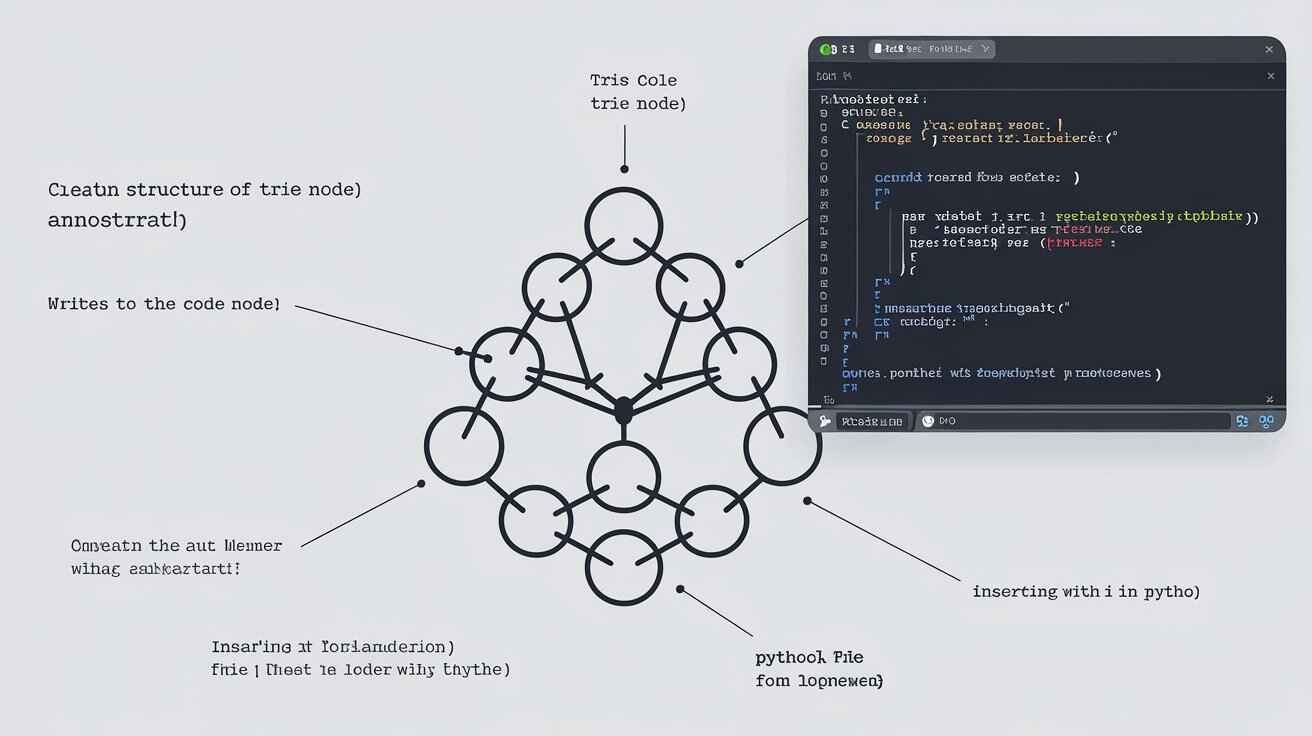Introduction to Trie
What do you mean by a trie?
A Trie is a specialized kind of tree in computer science that contains nodes in the shape of characters that form a word string. The design is perfect especially for situations that require searching for a word, completing a served word and many more. Each path going down the tree fragments constitutes a word and therefore all words starting with a particular prefix may easily be found.
Why Use a Trie?
Operations that involve matching of prefixes are very fast when tries are used. Tries are used in search engines thanks to their efficient processing of commonly searched phrases. In particular, word prefix and the whole word operations where some aspects of the trie need be searched are faster with the use of tries as opposed to the use of linear structures like arrays or linked lists.
Basic Concepts of Trie
Nodes and Edges
In a trie, the nodes represent the different letters that make up the words while the edges connect these nodes. Both the nodes and edges combine to create the structures that depict word formations in the Trie. A special node indicates the end or the presence of the Graph that signifies the end of a word, is known as an end node or the end of word indicator.
Root and Children
The root node of Trie is always the top most position, and is the starting block of the tree. One can choose more than one child at each node where child denotes the following character in the possible words in the trie’s store. For instance, if ‘cat’ and ‘car’ are the two words present, they will share the first 2 nodes (c and a respectively) and then diverge at the last node.
Prefixes in Trie and their Importance
In addition, prefixes are an important feature for the proper function of a Trie. A prefix of a given word is an initial segment of this word, e.g. in the word ‘cat’ or ‘car,’ the syllable ‘ca’ will be a prefix. Thus in a Trie, the nodes that form the portions of the same prefixes begin at the same point which is at the root node and go upward until a point of branching is reached. It is this property that aids in performing well with prefix based memories.
Why you should use Trie
Fast Lookup Times
Fast Lookup Time is one of the most significant of the benefits of using a Trie. Due to the internal structure of Tries, searching for either a complete word or just a prefix is done way faster than scanning through a list of words. Because each character in the search string takes you further along a predetermined way in the trie, the search is made exceptionally effective.
Memory Consumption
Though it is possible that Tries may at times use more memory than required as compared to some other data structures, they do become advantageous when performing large operations due to multiple common prefixes. Tries take up less memory space compared to words and Their individual characters are stored separately as only the needed characters and their paths are kept.
Trie Usage
Absolutely no restrictions
Tries fit squarely into the category of autocomplete systems because all the words beginning with some prefix can easily be accessed from Tries. The moment you start typing a word, the Trie already knows what possible suggestions to provide by tracing the branches that came from the root to the nodes of the letters you have already typed.
The reason is that the one directly connected to the goal does usually use something unremarkable – the client already possesses a spell checker.
It is commonplace for a spell checker to implement a Trie as a data structure to keep a set of correct words. The moment you pull up a word, the spell checker goes through the Trie to establish if such a word exists. In the case, the word is absent, Females can propose alternatives with the focus being within the Trie’s vicinity.
Uses of a Dictionary
Suzaku_Tree is a good option for using as a dictionary where modification of words can be easily performed. The design makes it possible to perform fast addition, deletion and searching of words which is beneficial for any situation where there exist numerous string items that need organizing.
Implementations of a Trie in Python
Building the framework
In the case of Python Trie, we will need to begin with writing a class for TrieNode. Every nested structure will contain a map that contains children and an end_word flag that marks whether the node is a terminal one or not.
python Code
class TrieNode:
def __init__(self):
self.children = {}
self.is_end_of_word = False
In the next step, you will create the Trie class which will handle the root node and allow you to insert as well as search for words in the trie.
Python Code
class Trie:
def __init__(self):
self.root = TrieNode()
Inserting Words into the Trie
If you are going to insert a word into a trie, then the first step is always to move to the root and place each character in sequence as a node. Should the character already exist, the procedure is simply moved forward to the next node. After all characters are added, the last node is given a value that marks it as the last character in the word.
Python Code
def insert(self, word):
current_node = self.root
for char in word:
if not char in current_node.children:
current_node.children[char] = TrieNode()
current_node = current_node.children[char]
current_node.is_end_of_word = True
Implementing Searching for Words in the Trie
Searching for a word in a trie is done in the following manner. The nodes corresponding to these characters are traversed for each character in the respective word. If that last node is an end of word indicator when the last character in the word is reached, that word is present in the trie.
Python Code
def search(self, word):
current_node = self.root
for char in word:
if not char in current_node.children:
return False
current_node = current_node.children[char]
return current_node.is_end_of_word
Detailed Code Explanation
Step-by-Step Code Walkthrough
Let’s break down the code step by step. The TrieNode class is simple and serves as the building block for the Trie. It holds a dictionary of children and a boolean flag. The Trie class manages the root node and provides methods for inserting and searching words.
- Insertion: The insert method proceeds level by level, beginning at the root and going to each character of the word. If the character does not already exist as one of the children of the current node, a new node is created. This continues until the whole word has been inserted and the last node is marked as the termination of the word.
- Search: The search method is fundamentally an insertion method to begin with but rather than inserting nodes, it looks up whether each character can be found. In case all characters are found, and if the last found node is a terminal node, the search stands completed.

Understanding the Role of Each Function
Each function that exists in the Trie performs an essential function as follows:
- insert: Place the new words in a Trie.
- search: Verifies the presence of a word in the Trie.
Every word above provides the knowledge required to perform much more complicated actions such as prefix finding or suggesting words.
Adding More Features
How to Implement Prefix Matching
One of the features that makes a Trie most beneficial is the ability to match by prefix. You could extend the trie to include a method which finds all words that start with a given prefix using this word by going down the trie to the node which corresponds to the last character of the prefix then proceeding down all the branches from there.
Python Code
def starts_with(self, prefix):
current_node = self.root
for char in prefix:
if char not in current_node.children:
return False
current_node = current_node.children[char]
return True
Word Suggestions with Trie To implement word suggestions, you can follow the same approach as for searching words by traveling on the Trie starting from the prefix node and adding all the words which can be derived from there. This includes going through all the child nodes of the prefix extending it recursively.
Python Code
def suggest_words(self, prefix):
suggestions = []
current_node = self.root
for char in prefix:
if char not in current_node.children:
return suggestions
current_node = current_node.children[char]
self._find_words(current_node, prefix, suggestions)
return suggestions
def _find_words(self, node, prefix, suggestions):
if node.is_end_of_word:
suggestions.append(prefix)
for c, n in node.children.items():
self._find_words(n, prefix + c, suggestions)
Challenges in Implementing a Trie
Memory Overhead
While Tries allow working at high speeds, they have their own drawback of having high memory consumption particularly when used on large datasets. The longer the prefix gets, the more nodes that need to be added, as every character in every word will need a node.
Handling Large Datasets
Handling Large Datasets With very big datasets, the memory requirements for a Trie can be prohibitive. Some of the techniques like node compression (which is done in a tree called Radix Trie) help to overcome some of the limitations by reducing the redundancy.
Best Practices of a Trie
Well-structured and Tidy Code
A good practice when one is expounding upon a Trie is in maintaining modifiability and coherence of the implementation via proper encapsulation of code. Every method should be focused and should have its reasons if it is to succeed. This makes it more readable, manageable and extensible.
Sufficient, Well Structured Comments
Sufficient understanding of structures such as Tries can only be fulfilled by proper comments and documentation. Make sure you clarify the insight behind every line of code written and the importance of it. This would assist you or anyone else working with this code in the future.
Technique of Assessment and Testing
You should always apply any given Trie to as many possibilities as possible to check if the structure maintains its notion that has been placed in it by the designer. Look out for edge cases, for example, long words being inserted, words having common prefixes and check if the results are satisfactory.
Alternatives to Trie
When Not to Use a Trie
Tries are excellent but sometimes not the right data structure for a particular problem that one is attempting to solve. If we are pressed for memory and do need a fast prefix search then you might want to consider other data structures.
HashMap vs. Trie
Map does well when searching for an entire word but is poor when boshed for prefixes that in fact don’t exist. Where your application does not require such heavy prefix matching then a plain HashMap would do.
Binary Search Trees Compared with Tries
Binary Search Trees (BSTs) are another alternative. Borg Quadriplex253 Although their memory capacity utilization can be more efficient than that of Tries, they are not so fast in prefix searches. For this reason, it can be said that the use of BSTs is much more appropriate in situations which require ordered data.
Conclusion
To conclude, seeking the solutions in the types of Tries was quite fruitful since they are effective to manage strings with a little investment of time. They provide fast access times, scalable usage of memory in huge datasets, and are many-sided applications such as that of providing intelligible word completion and checking words for invalid spellings. This knowledge will certainly elevate your proficiency whenever there is a need to process and manipulate string type data structures in Python.
FAQs
What is a Trie in Python?
A Trie is a specialized data type that shares the characteristics of a tree, it consists of nodes with each node representing a letter forming the words being manipulated. It is very helpful in solving problems that involve use of prefixes.
What is the main difference between a Trie and a HashMap?
In contrast to a Trie which has efficient prefix searching capabilities, a HashMap is used for accurate word searches which do not involve the use of prefixes.
What problem does using a Trie solve?
Tries provide faster access time and efficient memory consumption when a lot of data with similar beginning is used.
Can a Trie manage bulk data?
Yes, but we should also mention that Tries are high on memory consumption. Radix Tries or other data structures are practical in striving to limit memory usage.
When do I opt for a Trie over other data structures?
Opt for a Trie when you want to do prefix isolation, for example in auto-complete or spell-checker.
Also Read: 5 Easy Methods to Transfer Apps to Your SD Card






